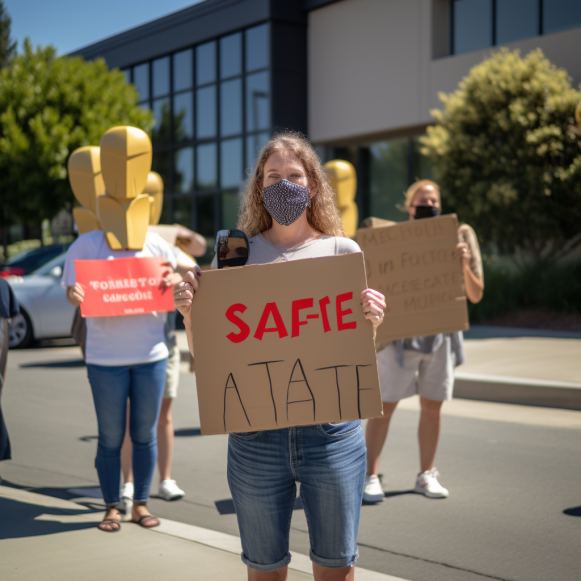Hollywood strikes begin to impact Bay Area, but actors and writers plan to stick it out

With no end in sight to the historic strike by Hollywood writers and actors, anyone in the Bay Area who relies on film and television productions for a living or to boost local events and city economies may soon feel the effects.
Thousands of actors, writers, and crew members in the Bay Area are out of work. Location shoots can generate hundreds of thousands of dollars per day for hotels, restaurants, and other businesses in San Francisco and other cities. And upcoming film festivals in San Jose and Mill Valley are unlikely to feature celebrity red carpet appearances, which add luster and help support those events.
Michael X Sommers, an Oakland actor, is one of the striking artists who says, “I’ve got to wait it out and do my best.” Sommers, a member of the SAG-AFTRA actors union, is one of the everyday Hollywood workers who contribute to the blockbuster films and critically acclaimed streaming series that keep the world entertained.
But Sommers and other employees who aren’t famous stars or hugely wealthy like Disney’s Bob Iger or Netflix CEO Ted Sarandos say it’s becoming increasingly difficult to make a living doing what they love, whether in the Bay Area or elsewhere. They claim they only receive a small portion of the billions of dollars earned by major studios and top executives since the advent of streaming.
The Alliance of Motion Picture and Television Producers, which represents the studios in negotiations, claims that streaming has benefited actors and writers by providing them with more opportunities to work, including on projects that would not otherwise be produced.
However, SAG-AFTRA and the Writers Guild of America (WGA) claim that this has not resulted in increased pay, consistent income, or better working conditions. Notably, residuals, which are long-term payments received by actors and writers when their work is rebroadcast on TV or sold on DVD, have plummeted in the age of streaming, making it difficult for them to pay bills in between gigs. One actor held up a 1 cent residual check during a protest outside Netflix’s Los Gatos headquarters on July 20.
Writers and actors are also concerned about the use of AI, fearing that it will be used to generate scripts or replicate images of background actors and stunt performers.
The last time the Screen Actors Guild (SAG) and the Writers Guild of America (WGA) went on strike at the same time was in 1960. In 2012, the Screen Actors Guild (SAG) merged with the American Federation of Television and Radio Artists (AFTRA).
“I’m doing my best to keep making a career out of acting,” said Sommers, who has appeared in “The Matrix Resurrections,” “Sorry to Bother You,” and Netflix’s “Sense 8.” For the time being, he’s working on a one-man play and fixing up his house, relying on his savings and residual checks from non-streaming projects. “Knock on wood: we come out of this strike well.”
One of the most visible effects of the strikes has been a ban on actors promoting new films at premieres and film festivals. During the London premiere of “Oppenheimer,” SAG-AFTRA announced its strike, prompting stars Cillian Murphy, Matt Damon, Emily Blunt, and Florence Pugh to leave the theater.
In the Bay Area, the Cinequest film festival begins this week in San Jose, with over 350 artists attending or presenting, though the actors involved will be non-SAG members, according to a spokesperson. Stars such as Brendan Fraser, Robert Pattinson, and Jamie Foxx have previously appeared at the Mill Valley Film Festival, which begins on October 5. The festival’s founder and director, Mark Fishkin, has not yet announced the lineup for this year, but has stated that it will include some of 2023’s “large awards contenders.” Whatever happens, Fishkin stated that the festival will operate within the union guidelines and with the “utmost respect for people who are trying to secure a living wage” in the industry.
It’s too early to tell how strikes will affect local economies, but Manijeh Fata, executive director of the San Francisco Film Commission, has already heard about two feature film productions that were considering San Francisco location shoots that are now on hold.
“Film productions in San Francisco have enormous economic benefits,” Fata said, citing a study that found film or television productions can inject up to $250,000 into a local economy on a daily basis. Over the last two decades, the Bay Area has lost productions to lower-cost destinations like Vancouver and Georgia, but filmmakers continue to flock to San Francisco and Oakland. “When crews work and stay in the community, it has a positive ripple effect on their families and the film community,” Fata explained.
Patrick Ranahan, a veteran location manager and writers guild member, shares Fata’s concern, but adds, “It’s about time for a strike.”
“You usually hear about four, five, or six (projects) on the horizon, and if one or two of them come to fruition, that makes for a great part of the year for a lot of people,” said Ranahan, a Bay Area location manager for 45 years. He had over 300 people working on “Shang-Chi and the Legend of the Ten Rings” alone.
“We opened the Fairmont Hotel during the pandemic and took up 11 floors,” said Ranahan. “Strikes affect literally hundreds, if not thousands, of people when extras, background actors, and crews are not working… That’s all over now.”
Heather MacLean, another location manager, is a member of the Teamsters union, which is not on strike but supports SAG-AFTRA and the WGA. “These strikes are absolutely necessary,” said MacLean, best known for his roles in “Sorry to Bother You” and the “Blindspotting” TV series. Working conditions on some major projects, she claims, have become untenable for “below-the-line” workers — a category that includes everything from gaffers and boom operators to make-up artists, sound engineers, and technicians — as profit-driven executives take over productions.
Rocky Capella’s nearly 200 stunt acting and coordination credits date back to the early 1970s and include “Terminator 2,” “Basic Instinct,” and “The Matrix Resurrections.” He recalls a Bay Area couple who made up to $100,000 a year working as background actors and doing commercials to put their children through college. With productions moving out of the Bay Area, this has become more difficult. Capella, on the other hand, blames declining residuals, pointing out that only about 12% of the 160,000 SAG-AFTRA members earn the minimum $26,470 per year required to qualify for health insurance.
He claims that “the greed” displayed by executives like Iger, who could earn $31 million this year, tells actors, particularly those who perform dangerous stunts, that their work isn’t appreciated. “Most stuntmen and women will do anything to get the right shot,” he explained. “They’ll do it over and over again.”






